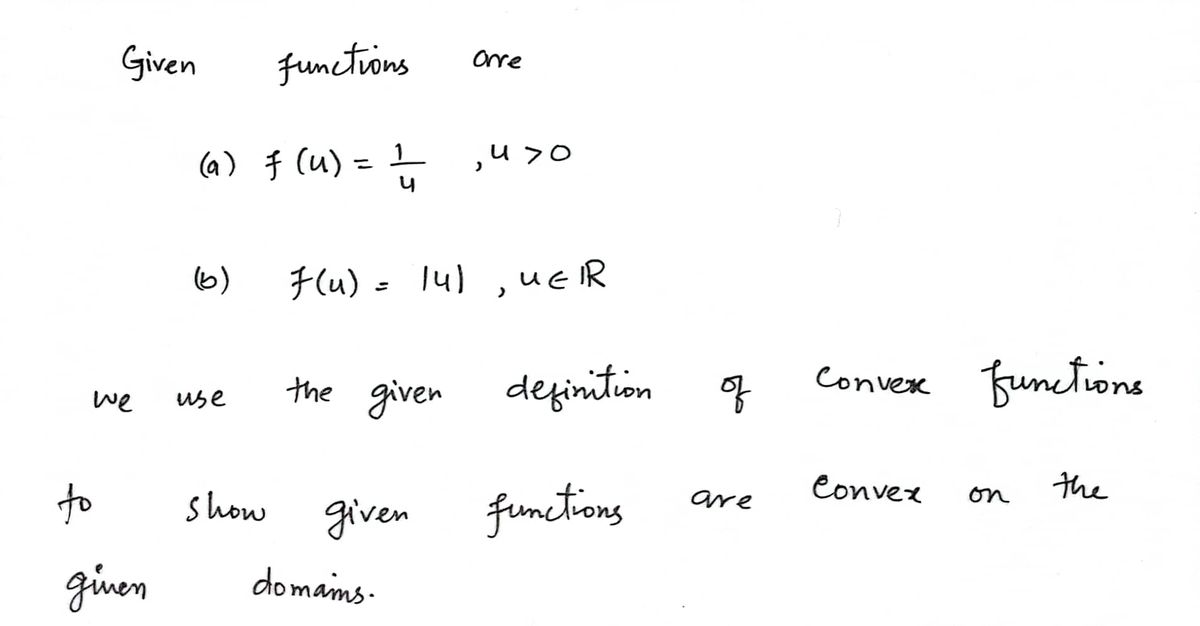1. Show that the following functions are convex by verifying the definition, i.e., that f(x + (1-A)y) ≤ f(x) + (1-A)f(y) is satisfied for all x, y in the domain of f and all A = [0, 1]: (a) f(u) = 1, u > 0, (b) f(u) u, u € R. =
1. Show that the following functions are convex by verifying the definition, i.e., that f(x + (1-A)y) ≤ f(x) + (1-A)f(y) is satisfied for all x, y in the domain of f and all A = [0, 1]: (a) f(u) = 1, u > 0, (b) f(u) u, u € R. =
Advanced Engineering Mathematics
10th Edition
ISBN:9780470458365
Author:Erwin Kreyszig
Publisher:Erwin Kreyszig
Chapter2: Second-order Linear Odes
Section: Chapter Questions
Problem 1RQ
Related questions
Question
Please help
![1. Show that the following functions are convex by verifying the definition, i.e., that
\( f(\lambda x + (1-\lambda) y) \leq \lambda f(x) + (1-\lambda) f(y) \)
is satisfied for all \( x, y \) in the domain of \( f \) and all \( \lambda \in [0, 1] \):
(a) \( f(u) = \frac{1}{u}, \, u > 0 \),
(b) \( f(u) = |u|, \, u \in \mathbb{R} \).
2. Show that the following functions are convex by verifying the condition that
\[ \nabla^2 f(x) \succeq 0 \]
is satisfied for all \( x \) in the domain of \( f \):
(a) \( f(u_1, u_2) = \ln(e^{u_1} + e^{u_2}) \),
(b) \( f(u_1, u_2, u_3, u_4) = \ln(1 - u_1 - u_2 - u_3 - u_4) \) over the domain \( \{ u \in \mathbb{R}^4 \mid u_1 + u_2 + u_3 + u_4 < 1 \} \).
3. Use the definition of a convex set to show that if \( S_1 \) and \( S_2 \) are convex sets in \( \mathbb{R}^{m+n} \), then so is their partial sum
\[ S = \{ (x, y_1 + y_2) \mid x \in \mathbb{R}^m, y_1, y_2 \in \mathbb{R}^n; (x, y_1) \in S_1, (x, y_2) \in S_2 \}. \]](/v2/_next/image?url=https%3A%2F%2Fcontent.bartleby.com%2Fqna-images%2Fquestion%2Fec417cb7-f4c3-4376-ad3a-c1f5cc0351ef%2Fdde0aa96-745c-46c2-8f73-ddb869a06b4a%2Fvnmct2_processed.jpeg&w=3840&q=75)
Transcribed Image Text:1. Show that the following functions are convex by verifying the definition, i.e., that
\( f(\lambda x + (1-\lambda) y) \leq \lambda f(x) + (1-\lambda) f(y) \)
is satisfied for all \( x, y \) in the domain of \( f \) and all \( \lambda \in [0, 1] \):
(a) \( f(u) = \frac{1}{u}, \, u > 0 \),
(b) \( f(u) = |u|, \, u \in \mathbb{R} \).
2. Show that the following functions are convex by verifying the condition that
\[ \nabla^2 f(x) \succeq 0 \]
is satisfied for all \( x \) in the domain of \( f \):
(a) \( f(u_1, u_2) = \ln(e^{u_1} + e^{u_2}) \),
(b) \( f(u_1, u_2, u_3, u_4) = \ln(1 - u_1 - u_2 - u_3 - u_4) \) over the domain \( \{ u \in \mathbb{R}^4 \mid u_1 + u_2 + u_3 + u_4 < 1 \} \).
3. Use the definition of a convex set to show that if \( S_1 \) and \( S_2 \) are convex sets in \( \mathbb{R}^{m+n} \), then so is their partial sum
\[ S = \{ (x, y_1 + y_2) \mid x \in \mathbb{R}^m, y_1, y_2 \in \mathbb{R}^n; (x, y_1) \in S_1, (x, y_2) \in S_2 \}. \]
Expert Solution
Step 1: Determination of given function
Since you have posted multiple questions, we will provide the solution only to the first question as per our Q&A guidelines. Please repost the remaining questions separately.
Step by step
Solved in 3 steps with 4 images

Recommended textbooks for you

Advanced Engineering Mathematics
Advanced Math
ISBN:
9780470458365
Author:
Erwin Kreyszig
Publisher:
Wiley, John & Sons, Incorporated

Numerical Methods for Engineers
Advanced Math
ISBN:
9780073397924
Author:
Steven C. Chapra Dr., Raymond P. Canale
Publisher:
McGraw-Hill Education

Introductory Mathematics for Engineering Applicat…
Advanced Math
ISBN:
9781118141809
Author:
Nathan Klingbeil
Publisher:
WILEY

Advanced Engineering Mathematics
Advanced Math
ISBN:
9780470458365
Author:
Erwin Kreyszig
Publisher:
Wiley, John & Sons, Incorporated

Numerical Methods for Engineers
Advanced Math
ISBN:
9780073397924
Author:
Steven C. Chapra Dr., Raymond P. Canale
Publisher:
McGraw-Hill Education

Introductory Mathematics for Engineering Applicat…
Advanced Math
ISBN:
9781118141809
Author:
Nathan Klingbeil
Publisher:
WILEY

Mathematics For Machine Technology
Advanced Math
ISBN:
9781337798310
Author:
Peterson, John.
Publisher:
Cengage Learning,

